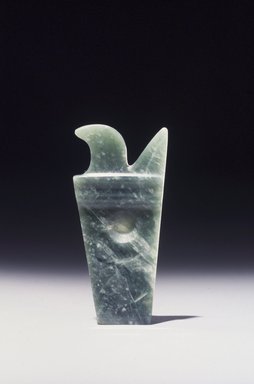
Artist:Olmec
Medium: Jadeite
Geograhical Locations:
Dates:800–500 B.C.E.
Dimensions: 3 3/16 x 1 1/2 x 1/4 in. (7.8 x 3.8 x 0.6 cm)
Collections:
Exhibitions:
Accession Number: L73.15.2
Image: L73.15.2_transpc002.jpg,
Catalogue Description: Carved jadeite plaque, trapezoidal in form and crowned at the top with a triangle on the right and curved scroll on the left; parallel lines below are carved in relief and there is a small, round indentation near the top. This object has been identified with headdress ornaments depicted on incised celts, and the form has been interpreted as a corn symbol. There are drill holes indicating that it was probably attached to a headdress. Text by GdeH 9/2011: During the time of the Olmec civilization (800-500 B.C.E.), the first maize imagery appears in the tropical lowlands of south-central Mexico in what are today’s states of Veracruz and Tabasco. This Olmec jade amuletic plaque is carved in the shape of what is believed to be a corn symbol. Images carved on ancient Olmec celts show plaques such as this worn in headdress ornaments, a function confirmed by the drill holes on the back and sides to facilitate attachment. Precious jade used as a medium to depict a corn stalk suggests that corn, and its attendant symbolism, was associated with the ruling elite.